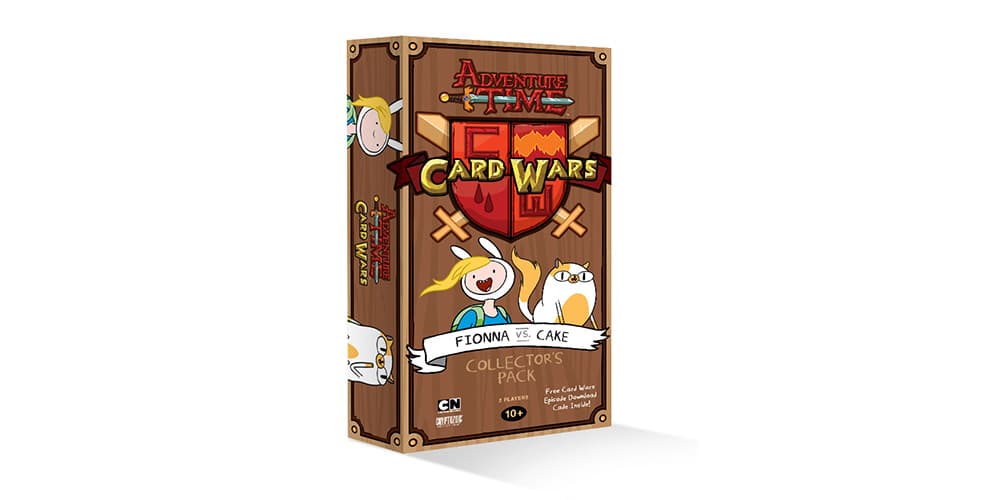2019’s Horrified by Ravensburger very quickly became one of the most talked-about games of the year, and so I know I wasn’t alone in being excited to take a look at the follow-up title. And thankfully, it doesn’t disappoint. A new set of monsters, taken this time from American myth rather than the movies, along with new art, a new setting, new investigators, and townsfolk, all combine with the familiar mechanics and gameplay of the original to bring us one of the best games of 2021.
What Is Horrified: American Monsters?
Horrified: American Monsters is a cooperative game for 1-5 players, ages 10 and up, and takes about 60 minutes to play. It’s currently available exclusively from Target for $27.99. It’s important to note the Horrified: American Monsters is an entirely stand-alone sequel, not an expansion of the original game.
The game was designed by Mike Mulvihill and published by Ravensburger, with illustrations by George Doutsiopoulos, Studio Hive, Kory Hubbel Lynn, Victor Maristane, Tom Moore, and Josh Newton.
Horrified: American Monsters Components

Included in the box are:
- 1 Game Board
- 6 Monster Mats
- 6 Monster Figures
- 7 Investigator Identification Tiles
- 7 Investigator Standees
- 13 Citizen Standees
- 60 Item Tokens
- 1 Frenzy Marker
- 1 Terror Marker
- 1 Item Bag
- 5 Reference Cards
- 3 Dice
- 30 Monster Cards
- 20 Perk Cards
- 7 Violins
- 4 Footprints
- 5 Photo Tokens
- 1 High School Overlay
- 1 Farm Overlay
- 7 Clue Tokens
- 1 City Hall Overlay
- 1 Eye of the Mothman
- 4 Trap Tokens
- 8 Death Marks
- 5 Trail Tokens
- 1 Abandoned Mile Overlay
The components are all of very high, finished quality.
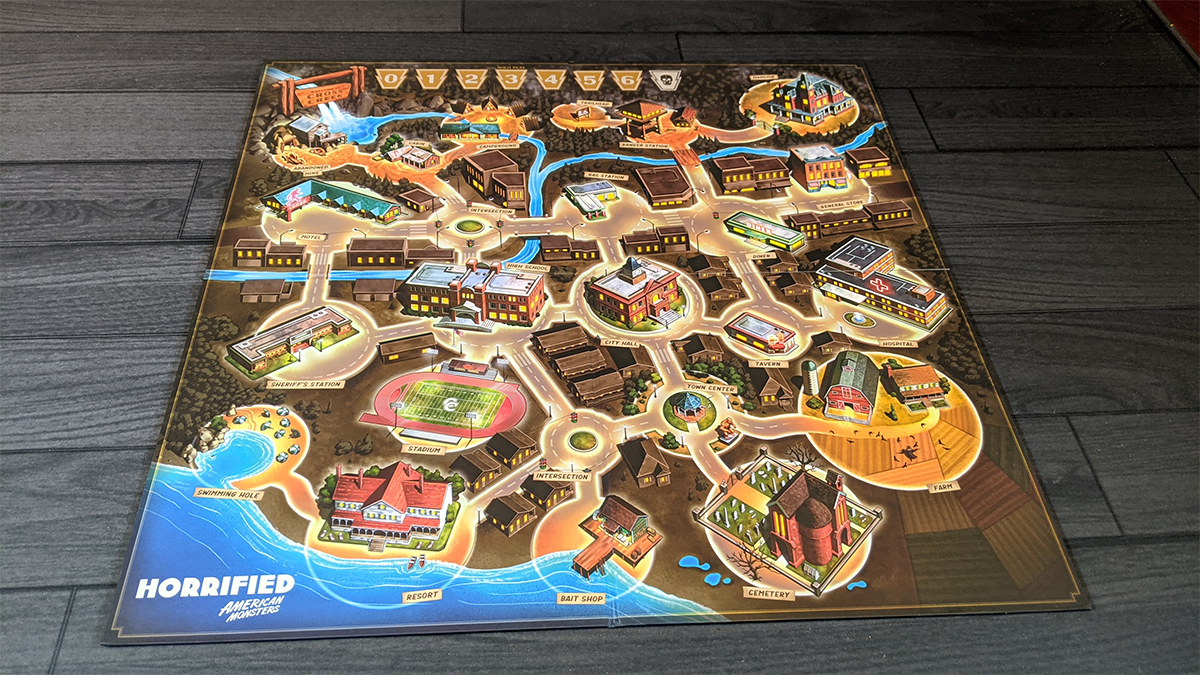
The board is about 2 feet square, and laid out with a map of Cross Creek, a small town that is unfortunate to be beset by a series of monsters from American myths: Bigfoot, the Banshee of the Badlands, Mothman, the Ozark Howler, the Chupacabra, and the Jersey Devil.

A fun added touch is that the back of the board includes a map of the US, showing where each of the monsters is supposedly from, and a note setting out the backstory for the game.

Each monster is represented by a plastic monster miniature. While they are each a single color, they have a surprising amount of detail. And each is distinct enough that you’re unlikely to get confused about who is who.
Pretty much everything else is cardboard, but maintain a level of both design consistency and detail to make for a very pretty game.
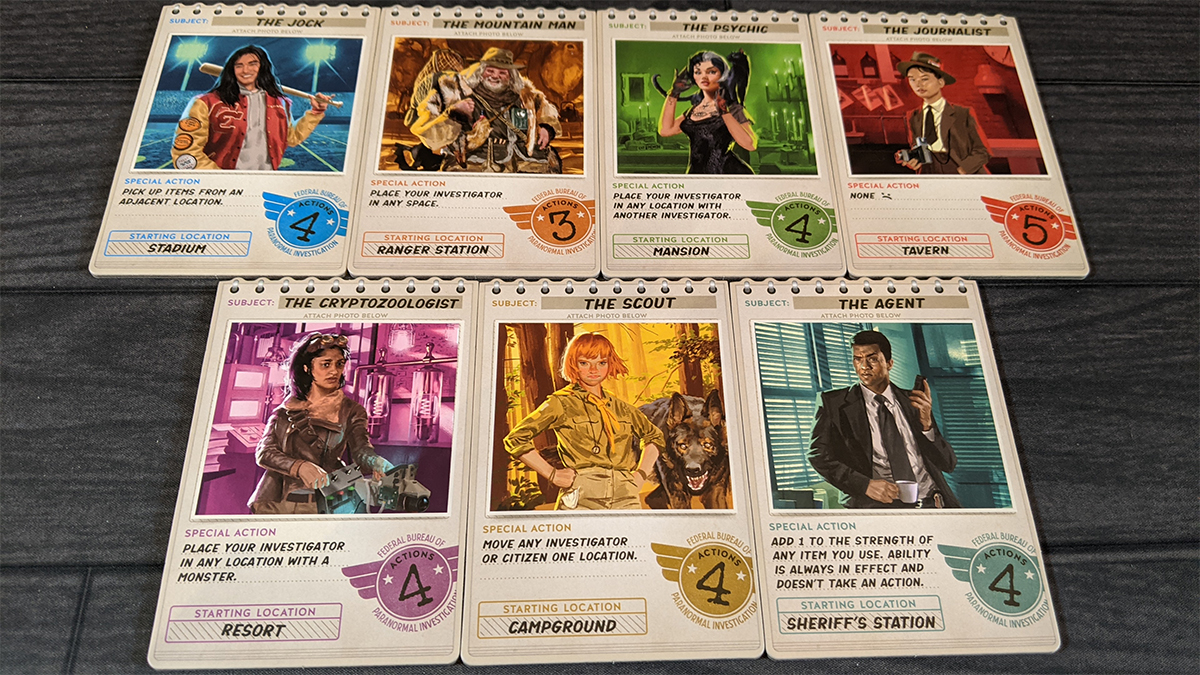
The investigator identification tiles are large pieces printed on heavy cardboard that provide all of the needed information for each player, including the number of actions allowed, the color, and the character’s special ability. A nice touch is that they are shaped as if they had been torn out of a spiral-bound notebook.

The matching (but much smaller) standees are color-coded twice, in the background of the art and the colored plastic stand, making it easy to find your character on the board.
The monster mats are made from heavy paper rather than cardboard, but they’re nice and big and provide both an easy reference to the things the monster does, along with a play area for tracking the players’ progress towards defeating the monster. The back of each of the monster mats contains the setup instructions for all of the monsters, so you can use mats for a monster you aren’t using in the current game to help set up.

Each monster plays a bit differently and has different victory conditions. This provides a lot of replayability but posed a design challenge. How do you not clutter the board up with a bunch of information for a monster that isn’t in the game? The solution here is done very nicely: each monster has a set of additional tokens used only when it is in play. Four of them add overlays to the board, but unlike in the original version of the game, these are just small tiles that are placed on the board, making storage much easier. The overlay is the only additional component needed for the Chupacabra, beyond of course its miniature.

Bigfoot adds an overlay, four footprints, and 5 photo tokens, which when combined form the famous blurry frame from the Patterson–Gimlin film.
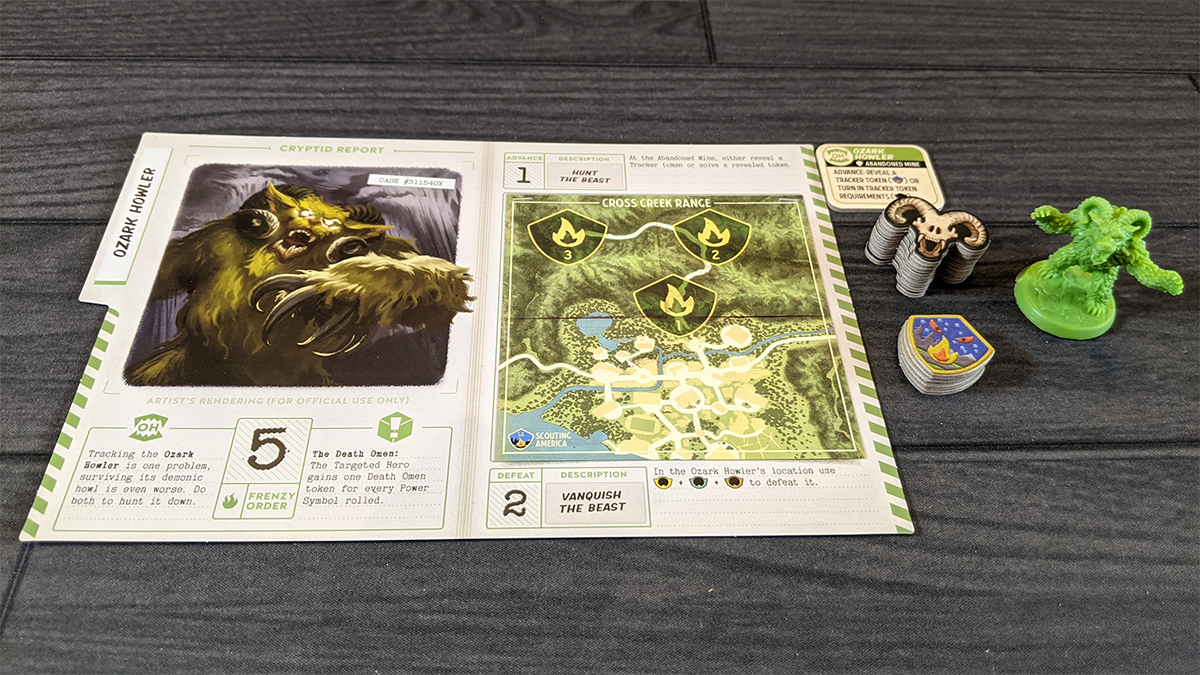
The Ozark Howler also has an overlay, but eight death masks and 5 trail tokens.
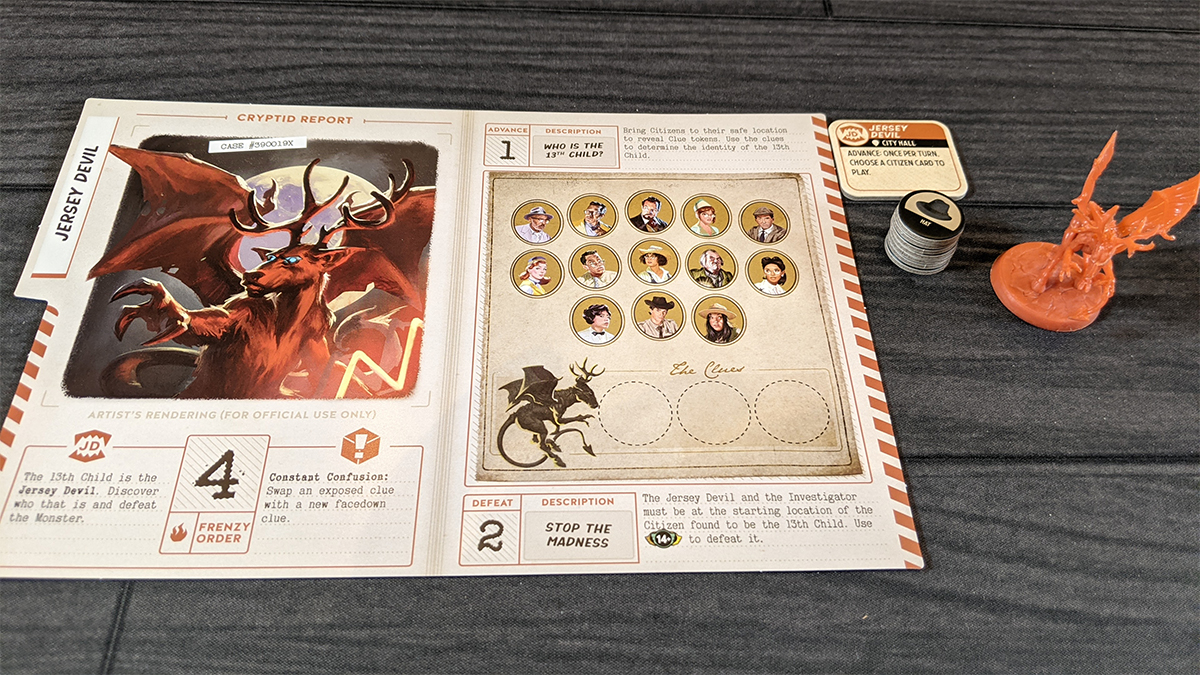
The Jersey Devil uses an overlay and seven clue tokens.

The Banshee of the Badlands doesn’t have an overlay, and instead includes seven violin tokens, each one matching one of the player colors.
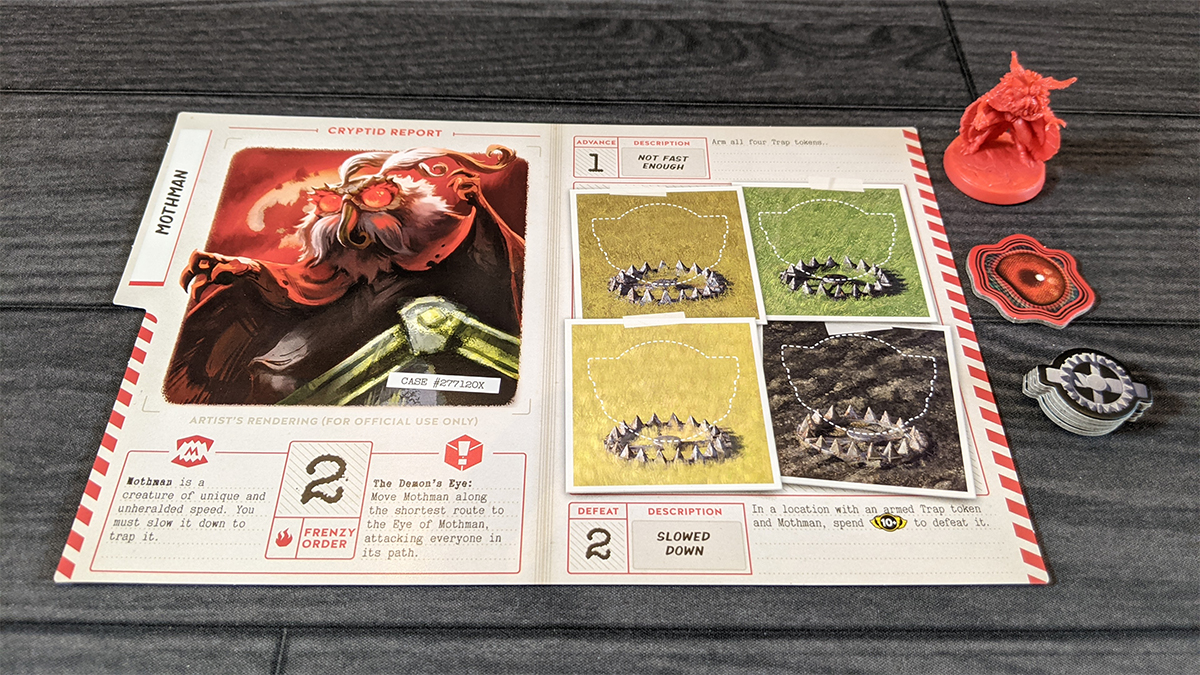
Mothman likewise doesn’t use an overlay. Rather, it has an Eye of the Mothman token and four trap tokens.
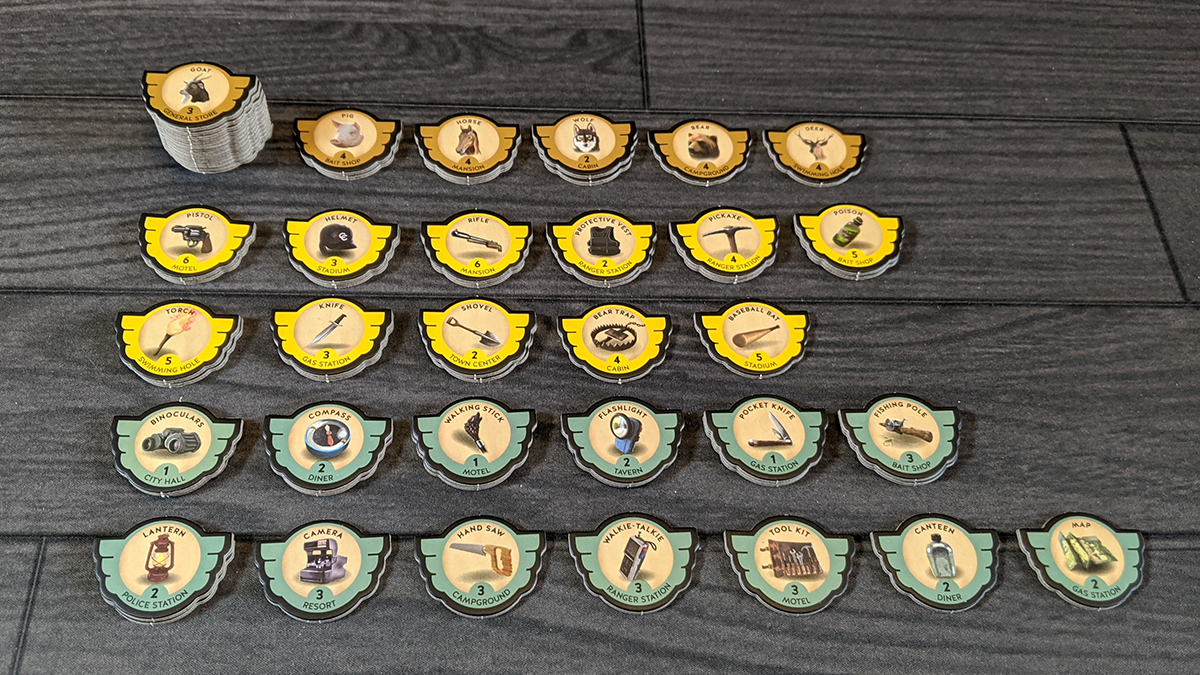
The item tokens were the one somewhat disappointing element in the original. Here’s what I had to say about them in that review:
There are sixty of them, divided into three colors (red, blue, and yellow). Each has a location, a picture and name, and a strength. There’s nothing inherently wrong with those, but as we played the game we realized that the name and art of the items was essentially flavor text and had no bearing on gameplay. You simply need X combined strength of Y color tokens against most of the monsters.
Unfortunately, this is an element that wasn’t fixed. The only change is that in American Monsters, the tokens are yellow, brown, and blue. One set of tokens—the goats—have a specific use against the Chupacabra, but otherwise, they are again nothing more than flavor text and art with semi-arbitrary point values.

The cloth bag from the first game used to draw the tokens has been replaced by a vinyl bag that feels cheaper but instead of being plain black, it is branded. It also is stiff, which allows it to stand upright, which honestly makes drawing tokens out of it a bit easier.

The final heavy cardboard elements are the frenzy and fear markers, which are identical to those in the original game. The frenzy marker is used to denote which monster activates the most frequently, and the fear marker is used to track the monster’s progress towards beating the players.

The game includes three custom six-sided dice, each with two blank sides, three “hit” sides, and one side that activate a monster’s special ability.

Finally, the game includes three sets of cards. The first is a set of reference cards, with the investigator’s turn sequence outlined on one side and the monster’s turn on the other.
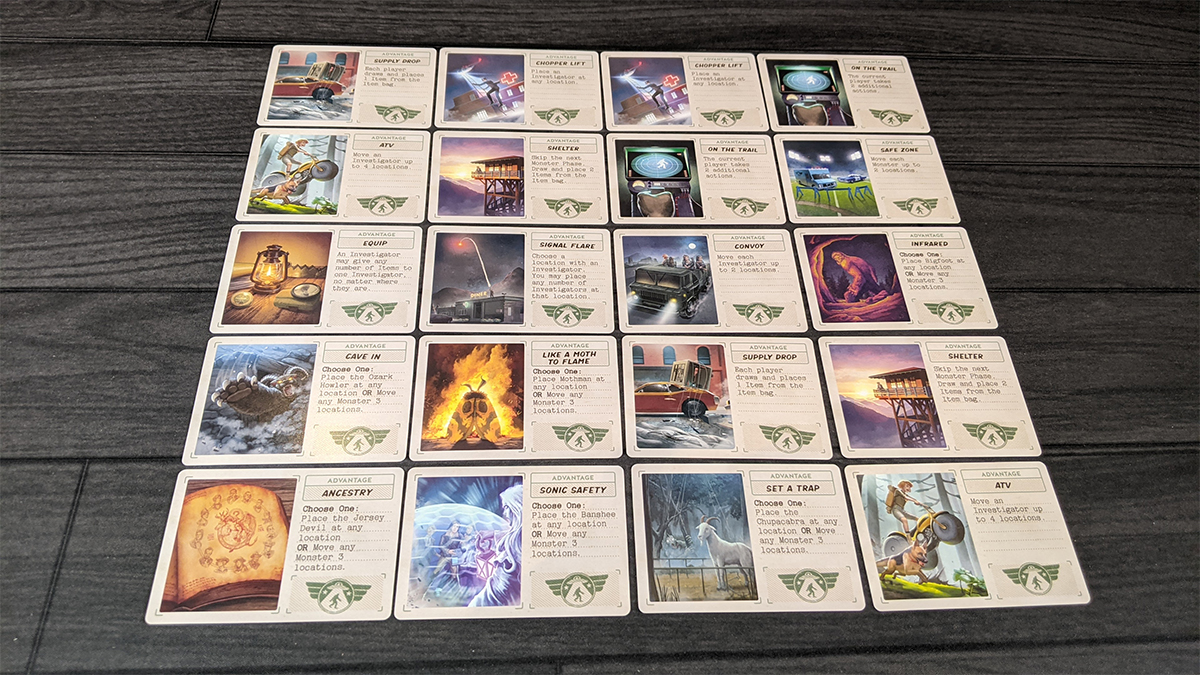
The second deck is the perk cards, which are special items or actions that players can use during the game to help them win.
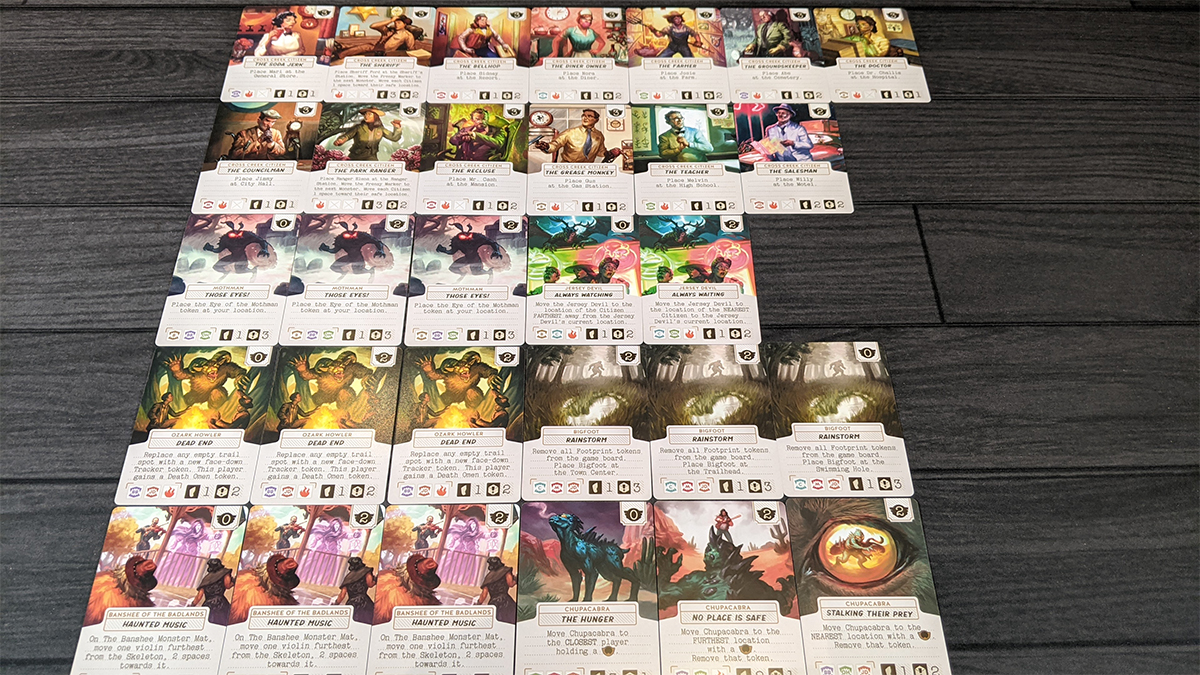
Finally, there’s the monster deck, which controls the movement and actions of the monsters. As with the first game, these cards break down roughly into two sets: there are cards that place townspeople on the board, and then there are monster cards. All of them allow players to draw and place new items from the bag, as well as activate the monsters. An interesting design choice is to have all of the monster cards in the deck at all times, but simply have players ignore the special instructions on any card that doesn’t match one of the monsters in play.
How to Play Horrified: American Monsters
The Goal
The goal of the game is to defeat two, three, or four (depending on the desired difficulty) monsters before they kill a certain number of citizens or investigators or before you run out of cards.
Setup

Place the board on the table. The terror marker is placed on the “0” spot on the terror level track at the top of the board. The citizens and dice are placed next to the board. The monster cards and perk cards are shuffled individually and placed next to the board.
Then, the players choose how many and which monsters to face. The rules suggest that you use the Banshee of the Badlands and the Chupacabra for the first (easy) game, any two random monsters for a novice game, three monsters for a standard game, and four monsters for a challenging game.
The monster setup depends on the monsters being used, which is detailed on the back of each of the Monster mats. For the first game, you set up the Banshee by placing its miniature on the cemetery space and then placing the violin matching the color of each investigator being used in the game on the first step of the track on the monster mat. The Chupacabra is set up by placing both its miniature and its farm overlay on the farm.
Once that is done, players choose their characters. This can be done randomly, or players can select the characters whose abilities will give them the best chance at defeating the chosen monsters.
Each player is then given one perk card. As this is a cooperative game, the cards are kept face-up.
Finally, the 60 Item tokens are shuffled and put in the bag. Twelve are drawn at random and placed on the location indicated on the token.
Gameplay
Each round is played in two phases.
According to the rules, the person who most recently saw a horror movie goes first, and then play proceeds clockwise from there.
The investigator phase is when the players move and try to accomplish tasks. Investigators have 3, 4, or 5 actions they may take, depending on the character. They can perform any of their actions in any order and may take the same action more than once.
The first possible action is move, where you move one space on the board. As all actions can be taken more than once, you can move up to the total number of actions your character has. If you are in a space with citizens, they can move with you. Movement is always restricted to the lighted path on the board. Players can move through monster spaces without stopping, or they may end their turn on a monster space. Any number of investigators or citizens may occupy the same space.
You can also guide citizens, where you can move one citizen from the investigator’s space to an adjacent space, or move one citizen from an adjacent space to your space. Moving citizens is important both to keep them away from the monsters and to get them to their desired locations (printed on their standees), which is the only way for players to get additional perk cards.
Any time a citizen gets to the location printed on their standee, they are removed from the game and the active player draws a perk card as a reward.
Perk cards can be played at any time, even during other players’ turns.
Investigators can pick up any number of items in their space as an action. They can also take an action to share any number of items with another investigator in their same space.

Investigators can use actions to fight the monsters. Investigators can take an action to advance a monster’s task. For example, an investigator on the farm space can drop off a goat they picked up elsewhere to advance the Chupacabra’s task. If the investigators have advanced the monster’s task to its endpoint and are in the same space as the monster, they can use an action to defeat the monster, based on its condition. Continuing the prior example, once six goats have been placed on the Chupacabra’s mat, a player may move to its space and use yellow items with a combined strength of 6 or more to defeat it.
Finally, investigators can use their special action, which varies amongst the characters.
Once a player completes their investigation phase, they draw the top card from the monster deck. At the top of each card is a number, and the player draws that many items from the draw bag and places them in the appropriate places on the board. Any number of items may be on any space.
Then, there may be an event. As I mentioned above, very often you will draw a card that calls for an event for a monster not in play. In those cases, you simply ignore the event and move on. But if you do draw one of the cards with a monster you’re playing against, you perform the action on the card.
Finally, the monsters move and may attack. At the bottom of each card is a diagram that shows which monsters will attack this turn. As with the events, it’s possible that players will get lucky and draw cards that have monsters that are not in play attack. However, if the monster is in play, it will move an indicated number of spaces and then attack any investigators or citizens in the space it ends up in.
Attacks are pretty straightforward: roll the indicated number of dice. If the hit symbol, which is on 3 of the 6 sides of the dice, is rolled, the monster scores a hit. If the blank is rolled, nothing happens. If the final symbol—the exclamation point—is rolled, then the monster’s special power is activated, which is spelled out on its monster mat.

Citizens are immediately killed on any hit by a monster in their space. The killed citizen is removed from the game, and the terror track is increased by one.
Investigators are likewise killed on a single hit, but they can deflect the hit by choosing to discard items instead. Again, the generic nature of the items rears its head again here, as any item can be used to deflect any hit. Players may discard as many items as needed to deflect any number of hits.
If the player cannot discard items, or chooses not to, they are hit. But they aren’t killed. Instead, their standee is removed from the board and placed on their investigator tile. At the beginning of their next turn, they are placed at the Hospital. They do not lose any items or perk cards they have in their possession. There will be times when players will decide it might be more strategic to hold on to items and let an investigator be hit. However, this does raise the terror track.
If there are both citizens and investigators in a space, the monster will always attack the investigators first.
Game End

The game ends when all of the monsters are defeated, at which point the players win. However, if the terror marker reaches the end of the terror track, or the players run out of cards in the monster deck, then the game ends with a victory for the monsters.
This game is GeekDad Approved!
Why You Should Play Horrified: American Monsters
Cooperative games should be hard. Sure, winning is fun, but winning when there’s no real challenge is an empty accomplishment, and results in a game that isn’t likely to be played again.
Of course, the flip side of that is true as well: losing all of the time also sucks, and a game that is just too hard isn’t likely to get played again, either.
So a good cooperative game needs to find that balance. It needs to be hard enough that players really feel like they’re probably going to lose, and in fact, that they do lose, but only some of the time—it’s just as important that players can win. And both Horrified games are in that sweet spot.
Yes, we won the first time I played the original game, and we won the first time we played American Monsters, too. But in both cases we were playing the “easy” setup, with the two easiest monsters, which even though the rules say it’s just the “suggested” set of monsters for the first game, I really think they’re designed as a sort-of tutorial, to let you get a feel for the rules without getting creamed in the process. (I should note, though, that the first time we played the original Horrified with the suggested first two monsters, the game was a bit too easy, but with American Monsters, we were pretty convinced we were going to lose about halfway through.)
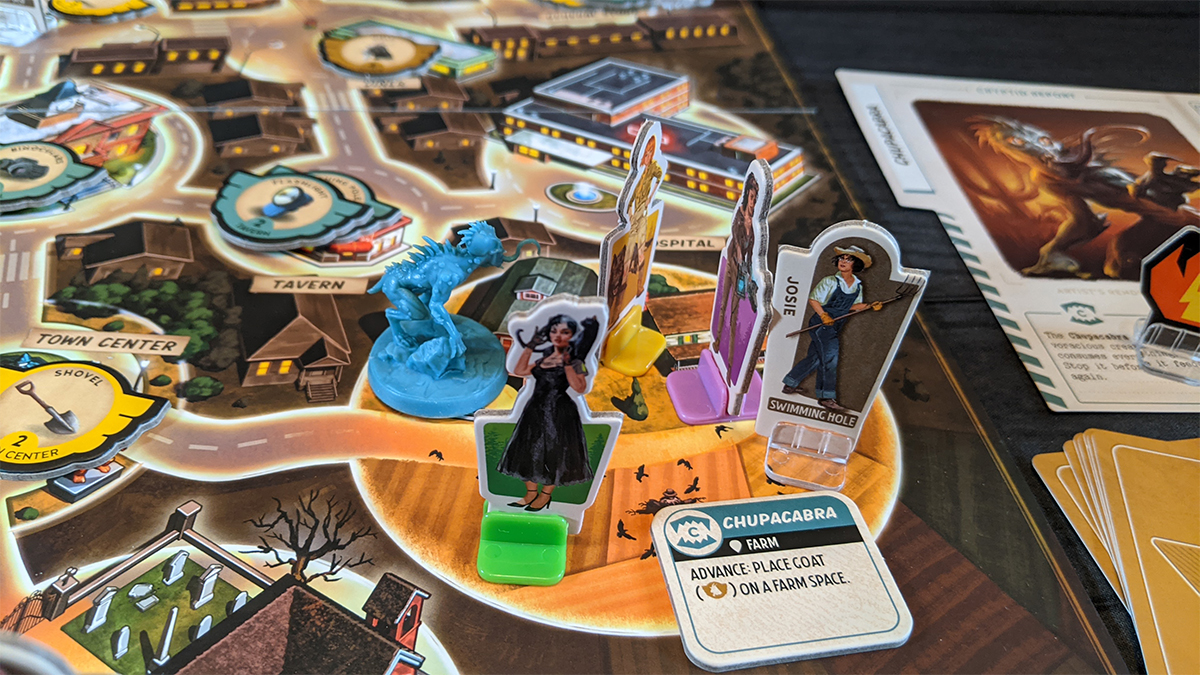
But the fact that they give you a group of monsters that have varying degrees of difficulty is one of the great design elements of the game. Go ahead and start with the Banshee and Chupacabra and, yes, expect to finish with a victory, but also with an understanding of the game. And then mix it up: select any two monsters at random and see what happens (spoiler: you’re maybe 50-50 to win.) Then try again with three. Or even four. You’ll be getting the full cooperative experience at that point, including losing more often than you win.
With American Monsters, Ravensburger took everything that was great about Horrified and tweaked it just enough to make it feel like it should—part of a franchise, with enough of the familiar to be clear this is still Horrified, but with enough new to make you comfortable taking up shelf space for two games.
If you want a good cooperative game that can be played in a fairly reasonable amount of time (about an hour) and offers a lot of replay value, plus has some great artwork and a monster-based theme that isn’t too scary for slightly younger family members, then you can’t go wrong with either Horrified title.
You can pick up your copy from your local Target store.
Click here to see all our tabletop game reviews.
To subscribe to GeekDad’s tabletop gaming coverage, please copy this link and add it to your RSS reader.
Disclosure: GeekDad received a copy of this game for review purposes.




